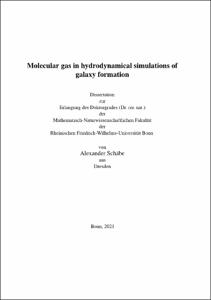Molecular gas in hydrodynamical simulations of galaxy formation

Molecular gas in hydrodynamical simulations of galaxy formation

| dc.contributor.advisor | Porciani, Cristiano | |
| dc.contributor.author | Schäbe, Alexander | |
| dc.date.accessioned | 2022-09-26T11:10:37Z | |
| dc.date.available | 2022-09-26T11:10:37Z | |
| dc.date.issued | 26.09.2022 | |
| dc.identifier.uri | https://hdl.handle.net/20.500.11811/10300 | |
| dc.description.abstract | Observations of nearby galaxies indicate a strong correlation between their molecular gas content and their star formation rate. This leads to the conclusion that molecular hydrogen – the most abundant molecule in galaxies – is the fuel for star formation. Recent results of sub-millimetre facilities like ALMA make it possible to study the molecular gas content in high-redshift systems. This fosters the understanding of the conditions for its formation and its impact at the early phases of galaxy formation – a fundamental building block in the topic of galaxy evolution.
However, there is a subtlety to the hydrogen molecule: its missing dipole moment makes a direct detection impossible. Thus, observations rely on so called tracers. Carbon monoxide is the most prominent tracer, but also neutral and ionized carbon have already been used for the determination of the molecular hydrogen content of a galaxy. Over the last years, numerical simulations have been used to approach the topic of galaxy formation from a theoretical perspective. Different models allow capturing a variety of effects in this highly complex process. Since these simulations have a limited resolution, they depend on subgrid models which are supposed to compensate for the incapability to include all effects in the interstellar medium such as the chemistry and the abundances of molecules. This becomes even more important for large cosmological volumes. Thus, to study the formation of molecular gas and its impact on star formation and galaxy evolution, subgrid models are essential. In this thesis, we will compare different recipes for the H2 formation in galaxies. Chapter 2 shows the results of a suite of cosmological simulations run with the adaptive-mesh-refinement code Ramses where different H2 formation models are implemented via a subgrid model. One model assumes chemical equilibrium, another one non-equilibrium between the processes of formation and destruction of H2. Lastly, we apply a semi-analytic model to the simulations which uses scaling relations for galaxies coming from observations in order to assign the molecular hydrogen mass to a dark matter halo at given redshift. We find that all models give similar results. Nevertheless, for morphology studies, running a high resolution simulation with a dynamic H2 formation model is the best choice. However, we find different results for the H2 content with respect to the resolution of a simulation. Applying observational limits to our simulated objects, we find a good agreement with current surveys. However, due to the limitations of observations, our results for the molecular gas budget on cosmological scales imply that observations still miss a significant amount of molecular gas that resides in undetected galaxies. In chapter 3, we extend the chemistry in our subgrid model used in chapter 2 to be able to trace neutral carbon, ionized carbon and carbon monoxide. For that, a simplified chemical network is embedded into the RAMSES code. This model is applied on-the-fly to a dwarf galaxy up to a reshift of z = 4 and in post-processing in a cosmological volume to the objects from chapter 2. In the end, we compare the outcome of the previously mentioned calculations with observational data for the abundance fractions of [C]/[H2] and [CO]/[H2] and find good agreement. The spatial distribution of CO coincides well with the H2 confirming that CO is a good tracer for dense star forming regions. Overall, the findings can be used in the future to run cosmological simulations that calculate the content of molecular gas tracers. In a next step, luminosity calculations for C, C+ and CO can be performed to enable a detailed study of the different dependencies of the conversion factor αCO – i.e. the relationship between molecular hydrogen and CO – as well as the reliability of other tracers. | en |
| dc.language.iso | eng | |
| dc.rights | In Copyright | |
| dc.rights.uri | http://rightsstatements.org/vocab/InC/1.0/ | |
| dc.subject | Galaxienbildung | |
| dc.subject | Galaxienentwicklung | |
| dc.subject | Molekulares Gas | |
| dc.subject | Simulation | |
| dc.subject | Numerik | |
| dc.subject | galaxy formation | |
| dc.subject | galaxy evolution | |
| dc.subject | molecular gas | |
| dc.subject | numerics | |
| dc.subject.ddc | 520 Astronomie, Kartografie | |
| dc.subject.ddc | 530 Physik | |
| dc.title | Molecular gas in hydrodynamical simulations of galaxy formation | |
| dc.type | Dissertation oder Habilitation | |
| dc.publisher.name | Universitäts- und Landesbibliothek Bonn | |
| dc.publisher.location | Bonn | |
| dc.rights.accessRights | openAccess | |
| dc.identifier.urn | https://nbn-resolving.org/urn:nbn:de:hbz:5-67908 | |
| ulbbn.pubtype | Erstveröffentlichung | |
| ulbbnediss.affiliation.name | Rheinische Friedrich-Wilhelms-Universität Bonn | |
| ulbbnediss.affiliation.location | Bonn | |
| ulbbnediss.thesis.level | Dissertation | |
| ulbbnediss.dissID | 6790 | |
| ulbbnediss.date.accepted | 30.06.2022 | |
| ulbbnediss.institute | Mathematisch-Naturwissenschaftliche Fakultät : Fachgruppe Physik/Astronomie / Argelander-Institut für Astronomie (AIfA) | |
| ulbbnediss.fakultaet | Mathematisch-Naturwissenschaftliche Fakultät | |
| dc.contributor.coReferee | Schneider, Peter | |
| ulbbnediss.contributor.gnd | 127861916X |
Dateien zu dieser Ressource
Das Dokument erscheint in:
-
E-Dissertationen (4337)




